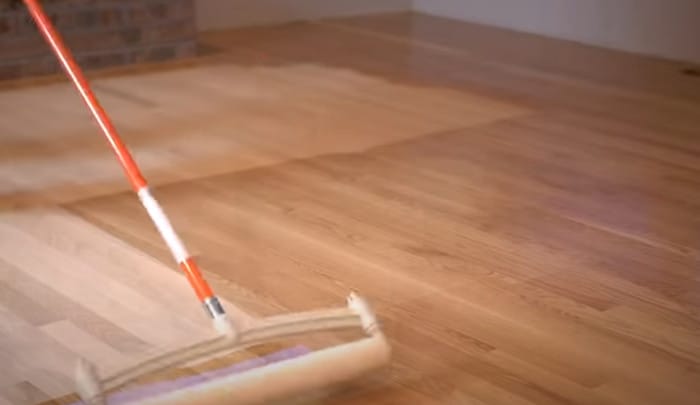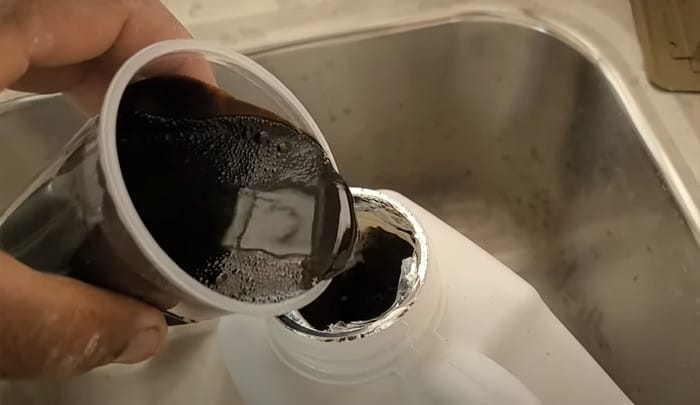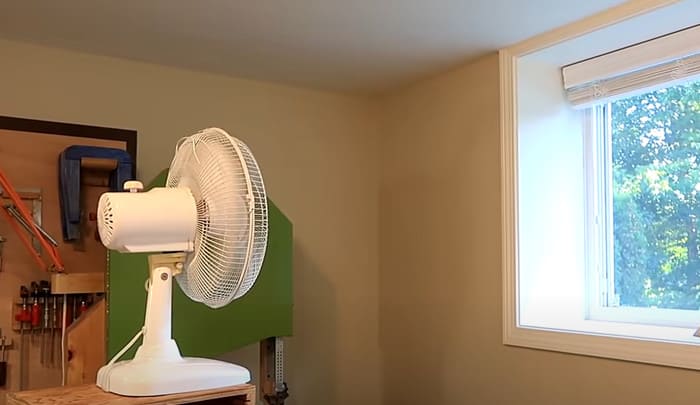You don’t need to call off a carpet installation crew when you decide to refinish your floors. Instead, you can take matters into your own hands, stay in your home, and give your floors a makeover.
Sounds like a great idea, right? While DIY-ing your flooring project may save you a few coins, it’s important to take certain safety precautions. In this blog post, we’ll cover what you need to know before you grab your tools and dive in to your refinishing project. So, roll up your sleeves and let’s get started!
- What is Refinishing?
- Why is Refinishing Dangerous?
- Can I Stay in My Home?
- What Safety Gear is Necessary?
- Ventilation and Adequate Spaces
- Furniture and Other Considerations
- Conclusion
- FAQ
- Are there any odors or fumes released during the floor refinishing process that would be harmful?
- What should be done to minimize dust and airborne particles during the floor refinishing process?
- What precautions should be taken to ensure the safety of those in the house while the floors are being refinished?
- References
It is not recommended that you stay in your house while the floors are being refinished, as the materials and fumes used in the process can be hazardous when inhaled. If possible, it is best to find alternative accommodations during this time.
“While some homeowners are tempted to continue living in their homes during a floor refinishing project, it’s a decision that needs careful consideration. High levels of dust, noise pollution, and the fumes from finishing products can be potential health risks, and the inconvenience can be significant. It’s essential to weigh these factors against the potential cost and disruption of temporary relocation.”
Vaughn Whitaker, Certified Renovation Specialist
What is Refinishing?
Refinishing a floor includes multiple steps such as repairing any damaged boards, sanding the surface of the floor, and applying a protective finish or sealer. This is done to improve the appearance of an older floor, or to help protect it from wear and tear. Refinishing can be done with either water- or oil-based products, which offer varying levels of protection and longevity.
For homeowners attempting their own refinishing projects, water-based products are usually the easier choice. These are easier to apply and do not release any noxious fumes. Oil-based products have a stronger odour, but they tend to hold up better against heavy foot traffic and frequent cleaning cycles. The downside of oil-based finishes is that they take longer to dry, so multiple days are typically needed in order for a thorough refinishing job.
Both types of finishes generally require light sanding between coats in order to achieve better results. For this reason, it is important to factor in some extra time when deciding if you can stay in your house while refinishing the floors. With careful preparation, wiping down the dust created by sanding and allowing enough drying time between each step, you should be able to complete a refinishing project without too much disruption to your everyday life—but it may be best to err on the side of caution here and plan for some nights away from home if possible.
No matter what type of product you decide to use for your project, it’s crucial to take safety precautions and read all instructions before beginning any refinishing process. And now that you know what is involved with refinishing a floor, let’s move onto the next section looking at what materials are used during the process.

Top Highlights
Refinishing a floor is a multi-step process that usually involves repairing any damaged boards, sanding, and applying a protective finish or sealer. Water-based products are often easier to work with but oil-based products may offer greater protection in the long run. Both types generally require light sanding between coats and it’s important to read all instructions before beginning. Safety precautions should also be taken during the refinishing process, and it may be best to plan for some nights away from home if possible.
What Materials Are Used?
When it comes to refinishing your own floors, one of the most important factors is what type of materials you use. The exact materials needed to refinish your floor depends largely on the existing floor and its size. Generally, however, here are some of the common supplies used for a successful refinish:
• Sandpaper or sander: Starting with 80-grit sandpaper, slowly increasing your grade will help smooth out the surface and remove old finishes. Renting an orbital sander from your local hardware store is an excellent way to get the job done quickly.
• Wood filler: If there are any gaping holes or cracks in the floorboards, wood filler can help. Make sure to apply a generous amount and level it off before it dries in order to create a smooth surface.
• Stain and/or paint: Depending on the look you’re going for, stain or paint should be applied after sanding is complete. Most paints and stains take 24 hours to dry before being able to apply additional coats or finishes.
• Polyurethane: Finally, applying Polyurethane as a finish seals all of that hard work and provides protection against everyday wear and tear. Whether you choose oil or water-based polyurethane all depends on personal preference, as both have their advantages and disadvantages.
Although completing a DIY home project can be both challenging and rewarding, some argue that refinishing floors on your own may not be the best idea due to potential risks associated with the task – particularly when working with harsh chemicals like polyurethane. On the other hand, some prefer tackling their own projects in order to save money without sacrificing quality. Whatever you decide, it’s always important to research safety protocols before beginning such a job – including proper ventilation and protective gear – especially if you plan on staying in your house while refinishing your floors.
The next section will delve into why refinishing is dangerous, what safety measures are necessary for staying safe during this process, and whether it’s better to hire professionals for large projects like these.
Why is Refinishing Dangerous?
Refinishing floors may seem like a desirable DIY project. However, if not done properly, refinishing wooden floors can be hazardous. Despite the common misconception that refinishing floors is a relatively safe task, there are several reasons why it can be dangerous for your health and safety.
One of the biggest dangers associated with refinishing hardwood floors is the use of chemical toxins. Many products used in refinishing contain potentially hazardous fumes, such as volatile organic compounds (VOC’s). These substances can cause significant physical health issues when inhaled in high concentrations over prolonged periods of time. Additionally, some of the chemicals used to refinish wooden floors are flammable, making them a potential fire hazard.
On the other hand, some individuals might argue that this risk is minimal if you take proper safety precautions when refinishing floors. Although it is important to take safety measures seriously, it is not always possible to limit exposure to certain toxic chemicals while refinishing inside a home. Even with proper ventilation, particles can still manage to make their way through a home’s air filtration system and into the living space.
Regardless of how much safety is taken into consideration before starting a re-finishing job, there will always remain some level of risk associated with such a task. Due to these factors, it is important for homeowners to understand the health implications before beginning a floor refinishing project themselves. The following section will discuss some of the potential health impacts associated with refinishing hardwood floors.

With this information in mind, it’s time now to explore the potential health impacts of refinishing your hardwood floors. Next up we will discuss: “Health Impacts”.
- The US Environmental Protection Agency recommends that individuals vacate the area during and up to 48 hours after floor refinishing is complete to avoid potential exposure to hazardous levels of airborne dust particles.
- According to a 2019 study, dust levels generated during hardwood floor refinishing may exceed recommended safety guidelines if proper dust containment measures are not taken.
- A comprehensive review of 70 studies published in 2017 concluded that floor finishing can generate volatile organic compounds (VOCs) hazardous to human health, with VOC concentrations remaining elevated for months after finishing processes were completed.
Health Impacts
No matter what type of floor refinishing you choose, there are health impacts to consider. It’s important to weigh the pros and cons before deciding if it is possible to stay in your home while refinishing the floors.
For example, sanding wooden flooring will create significant amounts of dust and particle pollution which can be hazardous to your health if inhaled. Floor sanders also use chemical solvents as part of the refinishing process and these chemicals can be toxic. The fumes from these solvents can cause dizziness, headaches and difficulty breathing even with proper ventilation.
On the other hand, if proper protective gear is worn like masks, safety glasses and gloves, the risk of health problems from wood dust and chemicals may be significantly reduced. Also, other types of floor refinishing such as buffing may create far fewer noxious fumes than sanding and therefore fewer health risks.
Overall, you’ll need to carefully assess the potential health risks of staying in your home while refinishing your floors before making a decision.
In the next section we will look at whether or not it is safe to stay in your home while refinishing the floors.
Can I Stay in My Home?
For many homeowners, the answer is certainly yes. But there are a few things to consider before deciding upon an in-home floor refinishing job. While not every floor refinishing project requires you to move out of your home, there are times when staying may not be feasible or safe.
The primary factor that can determine whether or not you should stay lies in the type of coating that will be used. Depending on the brand and composition of the product, it can emit powerful fumes that emanate into other parts of the home. If the fumes are inhaled, they could cause dizziness or even become a significant safety risk. While some refinishers opt for water-based products with lower VOC ratings (volatile organic compounds) to reduce these risks, higher VOC rates on certain sealers require greater ventilation and could necessitate a temporary relocation to safety.
Some refinishers also use heavy-duty sanders to strip away layers from heavily worn floors. This process creates a considerable amount of dust, which can irritate eyes and throats if inhaled for extended periods of time, again requiring a safe haven away from the work area. There are ways, however, to mitigate much of this dust by using a combination of special vacuum cleaners and tarping off the affected areas with plastic sheeting. Some companies do offer products that act as both sanders and vacuums themselves, eliminating almost all airborne contaminants during this step.
In particular instances where existing mechanics like heating radiators are present directly underneath the flooring being serviced, safety becomes an even more important issue since pockets of trapped heat can escalate levels of smoke beyond acceptable thresholds. In such cases it could be harder to keep fumes at bay and outside air may need to cycle through constantly while work is being done in order to avoid any potential ill health effects caused by poor ventilation during refinishing projects within the dwelling itself.
Ultimately it’s up to you as a homeowner to weigh these factors alongside any emotional connections you have with your current living space in order to make an informed and wise decision about whether or not you should stay put during a floor refinishing job.
To ensure you remain safe throughout your floor refinishing experience, read on for tips about how best to protect yourself and your family as you prepare for this transformation within your home environment. Next we will look at what tips homeowners should consider before deciding whether or not they stay in their home while their floors are being refinished.

Tips for Staying Safe
Staying safe while refinishing or redoing floors indoors can be a tricky task. Although it’s possible to stay in the house while carrying out the job, there are certain safety measures that should be taken if you do so.
Firstly, it is important to consider the degree of disruption that may occur as part of your project. If the disruption could potentially impact your daily routine, it is advisable to move out of the house and stay somewhere else until all works are completed. This will ensure that you remain healthy and not risk inhaling any toxic fumes.
It is also important to ensure proper ventilation in the room where you will be completing the work. Opening windows and using fans helps draw air away from the worksite, reducing airborne contaminants and providing some level of comfort when breathing. You may also want to invest in special filter masks, if available, as they can further reduce exposure related to dust or other particles.
If you intend on staying in your home during a floor refinishing project, it is also a good idea to wear protective clothing and limit your contact with newly-treated surfaces. Depending on what type of materials are used for redoing flooring, their components may cause skin irritation or other potential health concerns. Proper use of gloves and face masks can protect against these risk factors.
When considering whether or not to stay in your home during a floor refinishing project, it is important to weigh both sides of the argument before making a final decision. On one hand, leaving the premises might seem like an ideal solution – ensuring maximum safety for everyone involved as well as uninterrupted completion of works. On the other hand, staying at home could come with its own ‘costs’ such as loss of comfort, everyday routines or dynamics within households changing temporarily due to all works being done inside the premises.
To finish off this section safely and properly, it is necessary to cover any safety gear necessary for workers and homeowners who choose to stay in their house while refinishing floors. What safety gear is necessary? The following section will provide more information on this topic.
What Safety Gear is Necessary?
When refinishing your floors, it is essential that you take certain safety precautions to prevent inhalation of any toxic chemicals released in the process. Wearing the right type of safety gear is one of the most important parts of refinishing your floors.
The primary piece of safety equipment needed when refinishing or staining your floors is a respirator mask. Respirators can protect against dust, fumes, and wood stain vapors that are released when sanding or staining wood. Other measures for protection should also be taken such as wearing long-sleeved clothing and boots, safety goggles, and gloves. It’s best to consult with an expert on exactly which type of respirator and other safety gear will best suit your specific situation.
There are differing opinions regarding whether you should remain in your home while refinishing its floors. While some experts advise vacating the premises during the work, others insist that it’s safe enough to stay in the house if handled correctly by using the appropriate safety gear described above. In either scenario, ventilation remains a key factor in air quality and must be addressed regardless.
Now that we have discussed what safety gear is necessary while refinishing your floors, let’s move on to discussing how proper ventilation and creating adequate working spaces are essential elements of floor refinishing success.
Ventilation and Adequate Spaces
When it comes to refinishing the floors in your house, ventilation and adequate spaces play a necessary role. During the process of refinishing, strong chemicals are used and having proper ventilation is key to ensuring that the fumes do not linger on in the house causing harm to its occupants. Homeowners should ensure that there is ample circulation as well as an open window someplace in their home where fresh air can seep into the area and disperse the vapors that are created due to refinishing processes.
Moreover, having adequate space is also essential for refinished floors. Floors need to be sanded down before they can be completely coated with varnish or other solutions. Thus making it necessary to shuffle around furniture or any other items that may be cluttering up the area making it difficult for someone to work around effectively. Therefore, if a homeowner chooses to stay at their house during the process of refinishing, adequate spaces need to be made available for workers to access easily in order to complete the job quickly and efficiently.
It is possible for homeowners to stay in their house while renovations such as these take place; however, they need to ensure that adequate spaces are available and that proper ventilation is installed so that air quality doesn’t become affected. With these pieces sorted out correctly and all safety regulations adhered to properly, homeowners can safely stay in their houses while the flooring is being refinished. Moving forward, furniture and other considerations must be taken into account when finalizing arrangements to ensure a smooth renovation process.

Furniture and Other Considerations
When it comes to refinishing a floor, there are a few considerations that need to be taken into account when it comes to furniture and other items within the room. The first is the dust that is generated during the sanding process. These particles can get everywhere, including settling on furniture and in air vents. Moving larger pieces of furniture away from the area being worked on, or better yet out of the house altogether, can help keep messes down and reduce the potential for dust throughout the home.
Smaller items like area rugs and light fixtures can easily be moved away when refinishing wood floors. If the refinishing project is continuing over multiple days, large items may need to stay in place by covering them with plastic tarps to prevent dust accumulation.
In order to keep the finished product up to standard, all nails need to be removed prior to shaking drum sander or edger during refinishing. For many individuals, this could require pulling up carpets or stripping baseboards and trim within the room. On one side of the argument, this can add significant time and cost onto a project but on the other side, these steps are necessary in order for the finish product to look professional.
Due to potential hazards associated with refinishing hardwood floors – such as loud equipment noise from flooring machines, dangerous airborne particles and chemical fumes – it would be best if those living in the home could remain elsewhere for at least one night once sanding has commenced.
Conclusion
For individuals looking to refinish their hardwood floors, there are many considerations that need to be taken into account before starting a project. From proper safety precautions such as wearing protective gear to moving furniture away from areas being worked on, understanding these factors can ensure a successful outcome for any floor refinishing job. This article will now take a look at what conclusion can be drawn after discussing these items in detail.
Conclusion
The answer to the question “Can you stay in your house while refinishing the floors?” is complex and depends on a variety of factors. In some cases, it can be possible depending on the type of floor finish, local laws, and other considerations such as ventilation.
For hardwood floors, it’s generally safe to temporarily occupy the space while sanding and refinishing if proper safety precautions are taken with regards to ventilation and personal protective equipment. Vinyl, linoleum, and tile floors can also be refinished without displacing occupants as long as appropriate ventilation is maintained.
Homeowners should consider whether the risks and potential inconveniences associated with residing in the area during renovations is worth it for them. If there are any doubts about safety or adherence to appropriate protocols, it’s best to err on the side of caution by leaving the premises until work has been completed.
FAQ
Are there any odors or fumes released during the floor refinishing process that would be harmful?
Yes, there are odors and fumes released during the floor refinishing process that could be harmful. Sanding the floors releases potentially hazardous dust particles, which may contain chemicals from the products used as well as resins from the wood itself. Additionally, some finishes contain volatile organic compounds (VOCs), which can be both poisonous and flammable.
To minimize exposure to these dangerous particles and chemicals, it is important to wear a respirator mask when sanding or applying any materials. You may also want to make sure you have good ventilation in your house during the floor refinishing process by keeping windows and doors open. Finally, it’s best to not stay in the house during this time, since VOCs can linger for hours after being applied.
What should be done to minimize dust and airborne particles during the floor refinishing process?
To minimize dust and airborne particles during the floor refinishing process, it is important to use a dust control system. A dust control system will help to capture and contain airborne particles. This includes using a HEPA-filtered vacuum cleaner, a wall-mounted air filter, and/or using damp rags during the sanding process. To further reduce dust, ensure that any high-use household items are removed from the area and all soft furnishings (such as curtains and carpets) are covered with thick plastic sheeting. It is important to also ensure that any windows or doors are sealed off to prevent the spread of dust outside of the designated work area. Finally, wear a particle mask when sanding the floors for extra protection.
What precautions should be taken to ensure the safety of those in the house while the floors are being refinished?
Yes, you can stay in your house while the floors are being refinished. However, there are some safety precautions you should take to ensure everyone in the house remains healthy and safe. First and foremost, keep children and pets out of the area while the floors are being refinished as they are particularly vulnerable to high concentrations of chemicals used. Ventilate the space thoroughly by opening windows and using a fan to help exhaust fumes away from your home. Also, wear protective clothing such as a mask, long sleeved shirt and pants, chemical resistant gloves and eyewear. You should also make sure no one smokes or lights candles nearby as these can be dangerous within close proximity to VOCs (volatile organic compounds). Lastly, check with your flooring contractor before you start refinishing your floors to make sure they follow all safety guidelines when working in an occupied environment.
References
https://www.hgtv.com/lifestyle/real-estate/how-to-refinish-hardwood-floors





I once sanded my hardwood floor too aggressively, and ended up with uneven surfaces; remember: take it slow and patience is truly a virtue in this scenario.
True words, Archibald. I remember refinishing an old pine floor where the wood was uneven. Instead of sanding everything down to the lowest surface immediately, I deliberately took my time to identify the highpoints and gradually smoothened them out.
I can’t stress enough the importance of using the correct protective equipment when undertaking a floor refinishing job. Trust me, one slip-up can cost you a lot, both physically and financially!
Refinishing a floor is not as simple as it seems. Not only are the right tools necessary, but also a clear plan and proper worry-free mentality. I once rushed into the job without proper preparation and ended up having to redo the whole thing again which was time-consuming and expensive. It’s crucial to take your time, prepare, use appropriate safety gear, and be patient for the best results.
I can attest to the importance of planning for a refinishing project, having witnessed firsthand the consequence of rushing into it without proper preparation, countless hours wasted and unnecessary expenses ensued.
Consider the sustainability aspect as well, aside from cost and convenience. Wood floor refinishing can create a lot of waste, not just from removed wood but also the spent sandpaper and chemicals. From my years of experience in large-scale projects, I found that proper disposal protocols reflect not just respect for the environment but result in a more orderly workflow during project completion.
My attempt to DIY my living room floor resulted in a total mess – I forgot to turn off the central heating and ended up with a finish that wasn’t even close to being uniform because the varnish dried faster than I anticipated.
Sebastian, your incident with the central heating is a common mistake when refinishing floors. Always regulate room temperature during the process – varnish or any finish dries differently under various temperatures.